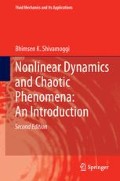Abstract
The goal of a physical theory is not only to give a precise mathematical formulation of observed phenomena but also to describe these effects with a minimum of fundamental postulates and in the most unified manner possible. Hamilton’s principle, which adopts a variational approach, is, in this sense, more fundamental than the Newtonian formulation.
Access this chapter
Tax calculation will be finalised at checkout
Purchases are for personal use only
Notes
- 1.
Lagrangian of a system is typically the difference between the kinetic energy and the potential energy of the system.
- 2.
In order to calculate the first variation of the action functional Φ, one compares the values of Φ that correspond to neighboring paths q(t) anchored on the same end points at t=t 1 and t 2 or
$$ \delta\textbf{q}(t)=\textbf{0}\quad\text{for}\ t=t_1\ \text{and}\ t_2. $$Thus,
$$ \delta\varPhi=\int^{t_2}_{t_1}L(q_j+\delta q_j,\dot{q}_j+\delta \dot{q}_j, t)\,dt -\int^{t_2}_{t_1}L(q_j,\dot{q}_j,t)\,dt. $$Expanding the integrand of the first integral to O(δq i ) and \(O(\delta\dot{q}_{i})\), we obtain
$$ \delta\varPhi=\sum^n_{j=1}\int^{t_2}_{t_1}\biggl(\frac{\partial L}{\partial\dot{q}_j}\delta q_j+ \frac{\partial L}{\partial\dot{q}_j}\delta\dot{q}_j\biggr)\,dt. $$Assuming that \(\delta\dot{q}_{j}=d/dt (\delta q_{j})\), and integrating the second term by parts, one obtains
$$ \delta\varPhi=\sum^n_{j=1} \biggl\{ \biggl[\frac{\partial L}{\partial\dot{q}_j}\delta q_j \biggr] \bigg\vert ^{t_2}_{t=t_1} +\int^{t_2}_{t_1} \biggl[\frac{\partial L}{\partial q_j}-\frac{d}{dt} \biggl(\frac{\partial L}{\partial\dot{q}_j} \biggr) \biggr] \delta q_j\,dt \biggr\} , $$or
$$ \delta\varPhi=\sum^n_{j=1}\int^{t_2}_{t_1} \biggl[\frac{\partial L}{\partial q_j}- \frac{d}{dt} \biggl(\frac{\partial L}{\partial\dot{q}_j} \biggr) \biggr]\delta q_j\,dt. $$ - 3.
H is typically the energy of the system.
- 4.
The Liouville equation for many interacting particles contains too much dynamical information to be of practical interest. Therefore, one typically seeks a reduced macroscopic description of the detailed underlying microscopic dynamics.
- 5.
An isomorphism is a linear transformation that is invertible.
- 6.
Alternatively, one may define a point (p,q) to be a wandering point of the map T if there exists a neighborhood W of (p,q) and a number N for which (T [s] W)∩W=∅ for all s>N; otherwise (p,q) is defined to be a non-wandering point. Poincaré’s Recurrence Theorem may then be restated as follows: For a Hamiltonian system with bounded motion, all points are non-wandering.
- 7.
Note that the coordinates and momenta do not remain necessarily distinct under such transformations (see Example 3.4).
References
H. Goldstein, C. Poole, J. Safko, Classical Mechanics, 3rd edn. (Pearson, Upper Saddle River, 2002), Chap. 10
I. Percival, D. Richards, Introduction to Dynamics (Cambridge University Press, Cambridge, 1982)
Author information
Authors and Affiliations
Rights and permissions
Copyright information
© 2014 Springer Science+Business Media Dordrecht
About this chapter
Cite this chapter
Shivamoggi, B.K. (2014). Hamiltonian Dynamics. In: Nonlinear Dynamics and Chaotic Phenomena: An Introduction. Fluid Mechanics and Its Applications, vol 103. Springer, Dordrecht. https://doi.org/10.1007/978-94-007-7094-2_3
Download citation
DOI: https://doi.org/10.1007/978-94-007-7094-2_3
Publisher Name: Springer, Dordrecht
Print ISBN: 978-94-007-7093-5
Online ISBN: 978-94-007-7094-2
eBook Packages: Physics and AstronomyPhysics and Astronomy (R0)

